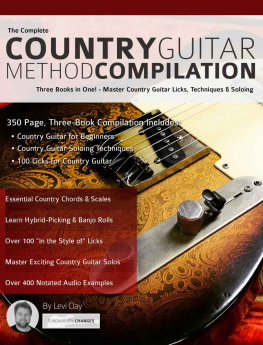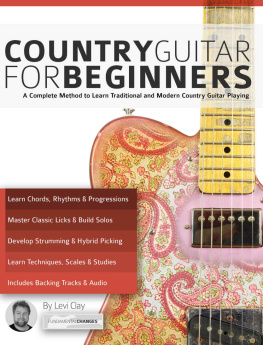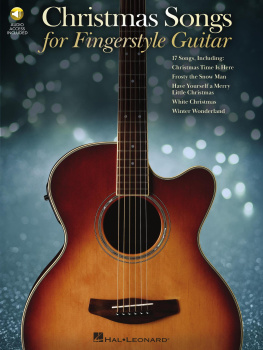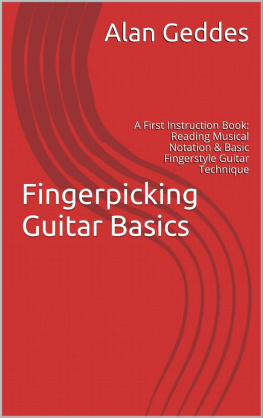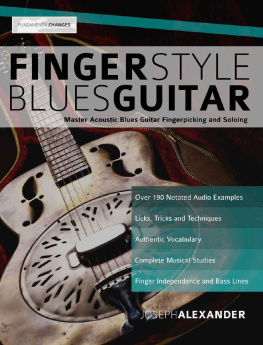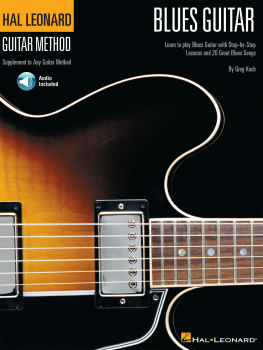Copyright 2017 Fundamental Changes Ltd.
The moral right of this author has been asserted.
All rights reserved. No part of this publication may be reproduced, stored in a retrieval system, or transmitted in any form or by any means, without the prior permission in writing from the publisher.
The publisher is not responsible for websites (or their content) that are not owned by the publisher.
Gretsch and Bigsby are trademarks of Fred W. Gretsch Enterprises, Ltd., and are used herein with express written permission. All rights reserved.
Cover photos courtesy of Fred W. Gretsch Enterprises, Ltd.
Other Books from Fundamental Changes
The Complete Guide to Playing Blues Guitar Book One: Rhythm Guitar
The Complete Guide to Playing Blues Guitar Book Two: Melodic Phrasing
The Complete Guide to Playing Blues Guitar Book Three: Beyond Pentatonics
The Complete Guide to Playing Blues Guitar Compilation
The CAGED System and 100 Licks for Blues Guitar
Fundamental Changes in Jazz Guitar: The Major ii V I
Minor ii V Mastery for Jazz Guitar
Jazz Blues Soloing for Guitar
Guitar Scales in Context
Guitar Chords in Context
The First 100 Chords for Guitar
Jazz Guitar Chord Mastery
Complete Technique for Modern Guitar
Funk Guitar Mastery
The Complete Technique, Theory and Scales Compilation for Guitar
Sight Reading Mastery for Guitar
Rock Guitar Un-CAGED: The CAGED System and 100 Licks for Rock Guitar
The Practical Guide to Modern Music Theory for Guitarists
Beginners Guitar Lessons: The Essential Guide
Chord Tone Soloing for Jazz Guitar
Heavy Metal Rhythm Guitar
Heavy Metal Lead Guitar
Progressive Metal Guitar
Heavy Metal Guitar Bible
Exotic Pentatonic Soloing for Guitar
Voice Leading Jazz Guitar
The Complete Jazz Soloing Compilation
The Jazz Guitar Chords Compilation
Fingerstyle Blues Guitar
The Complete DADGAD Guitar Method
Country Guitar for Beginners
Beginner Lead Guitar Method
Contents
Introduction
With its roots in ragtime, blues, and the pioneering Carter Family, fingerstyle and thumb-picking guitar runs deep in the veins of country music.
From Robert Johnsen to Elizabeth Cotton, fingerstyle guitar has always added interest to backing parts for vocal melodies by combining the voices of bass, chords and melody.
In the 30s the style was taken to the next level and made famous by Merle Travis. Travis use of a thumb-pick to play alternating bass patterns while picking out melodies with the index finger became so ubiquitous that nearly a century on, the style is still commonly referred to as Travis Picking.
The late, great, Chet Atkins deeper refinement of the technique was a natural evolution of style, and due to his huge reach as a player, producer and record executive, it became popular world over.
One anecdote youll repeatedly hear from modern fingerpickers is that they many assumed Chets multi-layered playing relied on recording tricks. His definition between bass and melody was so pronounced that without insider information youd be forgiven for thinking you were hearing more than one guitar.
Chet is still considered one of the most influential and innovative guitar players the instrument has ever known; up there with the likes of Les Paul, Jimi Hendrix, and Charlie Christian.
The next big name associated with the style is The Alabama Wild Man, Jerry Reed. Reeds style was born from the lineage of Merle and Chet, but delivered with ground-breaking flair and innovation.
Chet, Merle, and Reed are the three names considered the unspoken influences. Theyre the pillars of the style and you should know their work inside out.
However, the list of pioneers doesnt end there. With trailblazers like Buster B Jones, Tommy Emmanuel, Thom Bresh, Scotty Anderson, Doyle Dykes, Richard Smith, Brooks Robertson, and Martin Tallstrom (just to name a few), finger-picking is still very much alive and well.
Get the Audio
The audio files for this book are available to download for free from www.fundamental-changes.com and the link is in the top right corner. Simply select this book title from the drop-down menu and follow the instructions to get the audio.
We recommend that you download the files directly to your computer, not to your tablet, and extract them there before adding them to your media library. You can then put them on your tablet, iPod or burn them to CD.
On the download page there is a help PDF and we also provide technical support via the contact form.
Kindle / eReaders
To get the most out of this book, remember that you can double tap any image to enlarge it. Turn off column viewing and hold your kindle in landscape mode.
For over 350 Free Guitar Lessons with Videos Check out:
www.fundamental-changes.com
Over 10,000 fans on Facebook: FundamentalChangesInGuitar
Tag us for a share on Instagram: FundamentalChanges
Get the Tone Guitars and Amps
When it comes to country fingerstyle, there are a surprisingly wide variety of guitar tones created by the great players and the sound you want will be influenced by the players you enjoy.
The most iconic country guitars are, without a doubt, the Gretsch hollow-bodies made famous by Chet Atkins. Be it the 6120, or the Country Gentleman, these guitars have a unique sound due to the Bigsby tremolo system and highly sensitive FilterTron pickups. Theyre not essential to the style but are responsible for a big part of Chets iconic tone.
Merle Travis, the father of the style, played a selection of guitars and even had solid body electrics made for him before Leo Fender launched the Broadcaster. For the most part, Merle switched between various high-end acoustic guitars and semi-hollows like the Gibson 400.
Jerry Reed found his voice on the classical-style guitar and preferred the tone of nylon strings. His most iconic guitar was a modified 1968 Baldwin electric-classical with extreme cutaway. While he was occasionally seen with a Telecaster, the nylon-string was his trademark.
When Jerrys popularity grew, many companies made a move on the portable nylon string market, although few matched the quality of the Godin Multiac guitars. These were favoured by players like Buster B Jones and now Doyle Dykes. They combine the tone and feel of a nylon string with the portability and ease-of-amplification of an electric guitar.
Then there are the more traditional steel-string acoustics favoured by the likes of Tommy Emmanuel (who has a signature Maton guitar) and Marcel Dadi (who was often seen sporting an Ovation).
My personal choices (and the ones youll hear on the accompanying for the recordings) are the Godin Multiac, Sigma steel string, Gibson Howard Roberts, and Fender Telecaster. I lean towards the sound and feel of nylon strings myself, but appreciate the range of the tonal options found in many different instruments.
When it comes to amplification, something clean is the obvious choice. Chet used a 25-watt Standel made in 1954 on countless recordings, and occasionally a selection of more powerful amps like a Paul Rivera-modified Fender Princeton and the MusicMan RD-50s.
Many of the greats would just use a direct inject (DI) box straight to the PA system; its all about hearing the guitar in its purest form.


